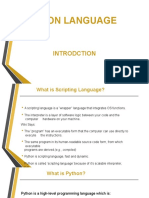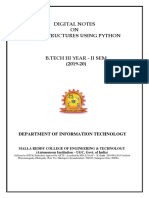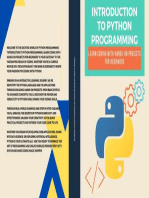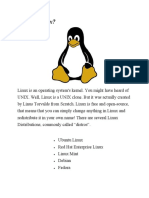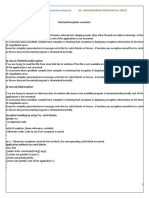0 ratings0% found this document useful (0 votes)
31 viewsPresented By: To:: Priyanka Rawat Bca B' Roll No. 32
This document provides information about an online Python course that the author has enrolled in through Swayam. The 19-week course is offered by IIT Bombay and instructed by Kannan Moudgalya. Python is introduced as a powerful, general-purpose, high-level programming language used across many domains that supports object-oriented, imperative, and functional programming. Key features of Python like being interpreted, extensible, embeddable, and having extensive libraries are highlighted. The document also provides a timeline of Python's history and releases as well as an overview of Python's basic types like strings, lists, tuples, dictionaries, and more.
Uploaded by
atul211988Copyright
© © All Rights Reserved
We take content rights seriously. If you suspect this is your content, claim it here.
Available Formats
Download as PPTX, PDF, TXT or read online on Scribd
0 ratings0% found this document useful (0 votes)
31 viewsPresented By: To:: Priyanka Rawat Bca B' Roll No. 32
This document provides information about an online Python course that the author has enrolled in through Swayam. The 19-week course is offered by IIT Bombay and instructed by Kannan Moudgalya. Python is introduced as a powerful, general-purpose, high-level programming language used across many domains that supports object-oriented, imperative, and functional programming. Key features of Python like being interpreted, extensible, embeddable, and having extensive libraries are highlighted. The document also provides a timeline of Python's history and releases as well as an overview of Python's basic types like strings, lists, tuples, dictionaries, and more.
Uploaded by
atul211988Copyright
© © All Rights Reserved
We take content rights seriously. If you suspect this is your content, claim it here.
Available Formats
Download as PPTX, PDF, TXT or read online on Scribd
You are on page 1/ 11
ONLINE COURSE:
PYTHON
Presented By: To:
Priyanka Rawat Mr.Atul Bhandari
BCA ‘B’
Roll No. 32
IN WHICH COURSE I
HAVE ENROLLED
I have enrolled in the course PYTHON through
Swayam.
This course is offered by the IIT Bombay and
this is 19 WEEKS long course.
The instructor of this course is Kannan
Moudgalya.
ABOUT THE COURSE
Python is a general-purpose, high-level, remarkably
powerful dynamic programming language that is
used in a wide variety of application domains.
Python supports multiple programming paradigms,
including object-oriented, imperative and functional
programming styles.
Python
Interpreted
◦ You run the program straight from the source code.
◦ Python program Bytecode a platforms native language
◦ You can just copy over your code to another system and it will auto-magically
work! *with python platform
Object-Oriented
◦ Simple and additionally supports procedural programming
Extensible – easily import other code
Embeddable –easily place your code in non-python programs
Extensive libraries
◦ (i.e. reg. expressions, doc generation, CGI, ftp, web browsers, ZIP, WAV,
cryptography, etc...) (wxPython, Twisted, Python Imaging library)
Python Timeline/History
In 1995, python 1.2 was released.
By version 1.4 python had several new features
◦ Keyword arguments (similar to those of common lisp)
◦ Built-in support for complex numbers
◦ Basic form of data-hiding through name mangling (easily bypassed
however)
Computer Programming for Everybody (CP4E) initiative
◦ Make programming accessible to more people, with basic “literacy” similar to
those required for English and math skills for some jobs.
◦ Project was funded by DARPA
◦ CP4E was inactive as of 2007, not so much a concern to get employees
programming “literate”
Python Timeline/History
In 2000, Python 2.0 was released.
◦ Introduced list comprehensions similar to Haskells
◦ Introduced garbage collection
In 2001, Python 2.2 was released.
◦ Included unification of types and classes into one hierarchy,
making pythons object model purely Object-oriented
◦ Generators were added(function-like iterator behavior)
Standards
◦ http://www.python.org/dev/peps/pep-0008/
Python types
Str, unicode – ‘MyString’, u‘MyString’
List – [ 69, 6.9, ‘mystring’, True]
Tuple – (69, 6.9, ‘mystring’, True) immutable
Set/frozenset – set([69, 6.9, ‘str’, True])
frozenset([69, 6.9, ‘str’, True]) –no duplicates & unordered
Dictionary or hash – {‘key 1’: 6.9, ‘key2’: False} - group of key and value
pairs
Python types
Int – 42- may be transparently expanded to long through 438324932L
Float – 2.171892
Complex – 4 + 3j
Bool – True of False
Python semantics
Each statement has its own semantics, the def
statement doesn’t get executed immediately like
other statements
Python uses duck typing, or latent typing
◦ Allows for polymorphism without inheritance
◦ This means you can just declare
“somevariable = 69” don’t actually have to declare a type
◦ print “somevariable = “ + tostring(somevariable)”
strong typing , can’t do operations on objects not defined
without explicitly asking the operation to be done
Python for the future
Python 3.0
◦ Will not be Backwards compatible, they are attempting to fix “perceived”
security flaws.
◦ Print statement will become a print function.
◦ All text strings will be unicode.
◦ Support of optional function annotation, that can be used for informal type
declarations and other purposes.
Thank You
You might also like
- Winning Proposal Writing Training Workshop Report: September 2021No ratings yetWinning Proposal Writing Training Workshop Report: September 20216 pages
- Introduction To Python: A Readable, Dynamic, Pleasant, Flexible, Fast and Powerful LanguageNo ratings yetIntroduction To Python: A Readable, Dynamic, Pleasant, Flexible, Fast and Powerful Language71 pages
- Chap-1 Introduction to Python ProgrammingNo ratings yetChap-1 Introduction to Python Programming16 pages
- Data Structures Using Python 1737761630No ratings yetData Structures Using Python 173776163089 pages
- Ansh Bhawnani: Python Beginner's Course Bitten Tech100% (1)Ansh Bhawnani: Python Beginner's Course Bitten Tech26 pages
- Program Name: B.Tech Semester:6TH Course Name: Course Code: Facilitator Name:ANTIM PANGHALNo ratings yetProgram Name: B.Tech Semester:6TH Course Name: Course Code: Facilitator Name:ANTIM PANGHAL13 pages
- Data@structures - Using Python-123456789No ratings yetData@structures - Using Python-123456789121 pages
- Python: A Readable, Dynamic, Pleasant, Flexible, Fast and Powerful LanguageNo ratings yetPython: A Readable, Dynamic, Pleasant, Flexible, Fast and Powerful Language27 pages
- Python Programming: Ii B.Tech (Cse) - I Semester (R19)No ratings yetPython Programming: Ii B.Tech (Cse) - I Semester (R19)22 pages
- Python programming and its packages DagimNo ratings yetPython programming and its packages Dagim17 pages
- A Summer Training Report On Python and It's Libraries Under The Guidance ofNo ratings yetA Summer Training Report On Python and It's Libraries Under The Guidance of20 pages
- Introduction to Python Programming: Learn Coding with Hands-On Projects for BeginnersFrom EverandIntroduction to Python Programming: Learn Coding with Hands-On Projects for BeginnersNo ratings yet
- B.SC IT - 4th SEM Modeling and Simulation UNIT 3No ratings yetB.SC IT - 4th SEM Modeling and Simulation UNIT 312 pages
- Neglected and Underutilized Crop Species The Key To Improving Soil Nutritional Security For Fighting Poverty, Hunger and Malnutrition in North-Western IGP: A ReviewNo ratings yetNeglected and Underutilized Crop Species The Key To Improving Soil Nutritional Security For Fighting Poverty, Hunger and Malnutrition in North-Western IGP: A Review8 pages
- Report On NAAC - Workshop at Mizoram UniversityNo ratings yetReport On NAAC - Workshop at Mizoram University6 pages
- A Method For Selection of Power MOSFETs To MinimizNo ratings yetA Method For Selection of Power MOSFETs To Minimiz8 pages
- Unitary Extension Principle For Nonuniform Wavelet Frames in L 2 (R)No ratings yetUnitary Extension Principle For Nonuniform Wavelet Frames in L 2 (R)17 pages
- Effective Strategies For Project-Based Learning of Practical ElectronicsNo ratings yetEffective Strategies For Project-Based Learning of Practical Electronics14 pages
- Control of Stock Consistency in Head Box Approach Flow SystemNo ratings yetControl of Stock Consistency in Head Box Approach Flow System6 pages
- A Phylogenetically-Restricted Essential Cell Cycle Progression Factor in TheNo ratings yetA Phylogenetically-Restricted Essential Cell Cycle Progression Factor in The45 pages
- String and Stringbuffer Exercise: Cognizant Technology SolutionsNo ratings yetString and Stringbuffer Exercise: Cognizant Technology Solutions6 pages
- A Half-Hour To Learn Rust - Fasterthanli - Me100% (1)A Half-Hour To Learn Rust - Fasterthanli - Me45 pages
- Fundamentals of Computing & Computer Programming Unit V - 2 MarksNo ratings yetFundamentals of Computing & Computer Programming Unit V - 2 Marks32 pages
- Continuation-Passing, Closure-Passing Style: Andrew W. Appel Trevor JimNo ratings yetContinuation-Passing, Closure-Passing Style: Andrew W. Appel Trevor Jim11 pages
- Department of Computer Science: HCT216: Programming 2No ratings yetDepartment of Computer Science: HCT216: Programming 223 pages
- UNIT-1 Introduction To Python ProgrammingNo ratings yetUNIT-1 Introduction To Python Programming10 pages
- CS 11 C Track: Lecture 1: PreliminariesNo ratings yetCS 11 C Track: Lecture 1: Preliminaries60 pages
- Introduction To Greenfoot: The Little Crab: With Thanks To Bruce Chittenden and Michael KollingNo ratings yetIntroduction To Greenfoot: The Little Crab: With Thanks To Bruce Chittenden and Michael Kolling30 pages
- Faculty of Computer Studies M251 Object Oriented Programming With JAVA MOCK Midterm Examination Fall - 2019-2020No ratings yetFaculty of Computer Studies M251 Object Oriented Programming With JAVA MOCK Midterm Examination Fall - 2019-20207 pages
- Exception Handling SPL Material by SravanNo ratings yetException Handling SPL Material by Sravan21 pages





